Webcam Shutter
TSAI; Ming-Shan
U.S. patent application number 16/264289 was filed with the patent office on 2019-05-30 for webcam shutter. The applicant listed for this patent is HEWLETT-PACKARD DEVELOPMENT COMPANY, L.P.. Invention is credited to Ming-Shan TSAI.
| Application Number | 20190163034 16/264289 |
| Document ID | / |
| Family ID | 56543979 |
| Filed Date | 2019-05-30 |


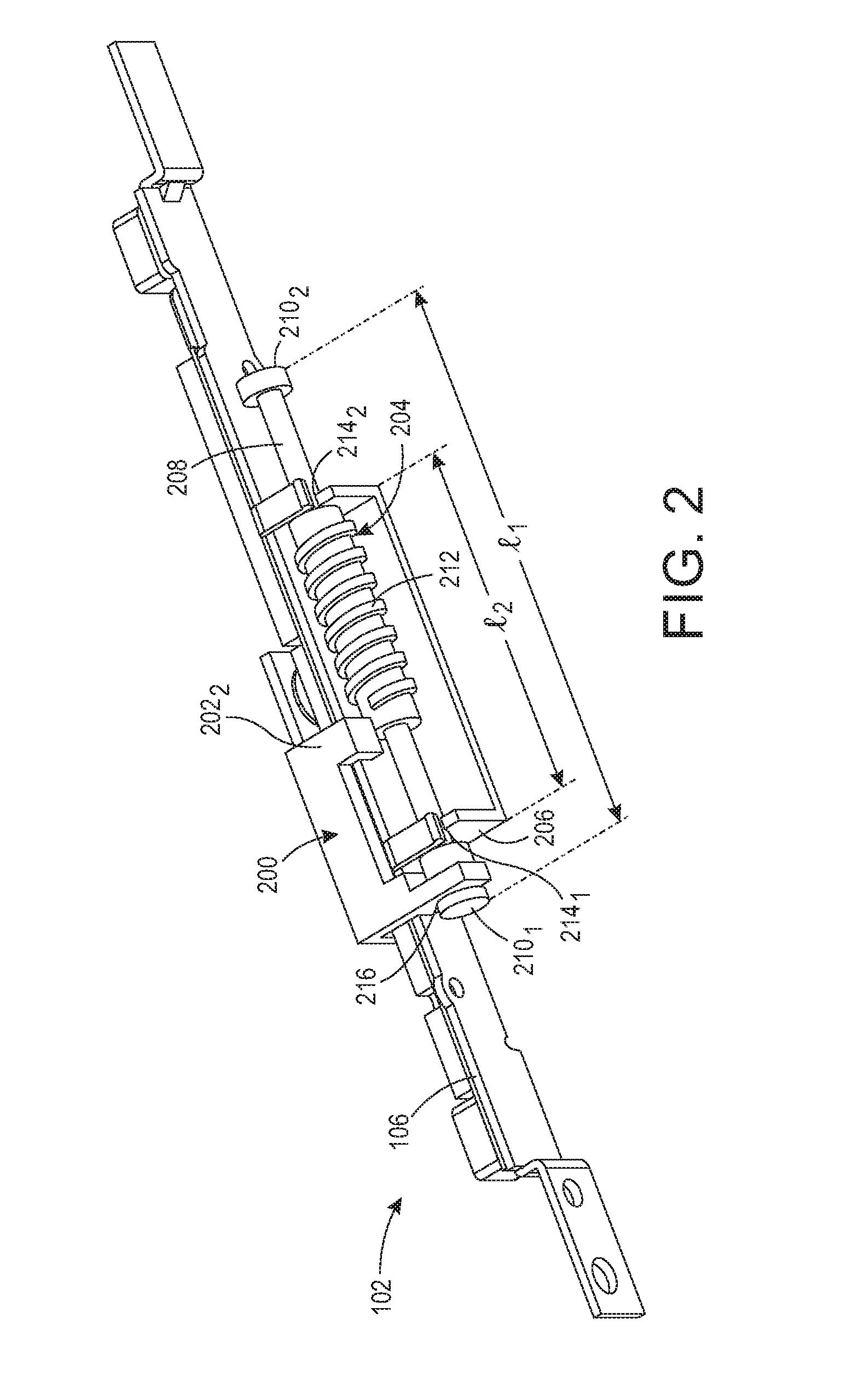
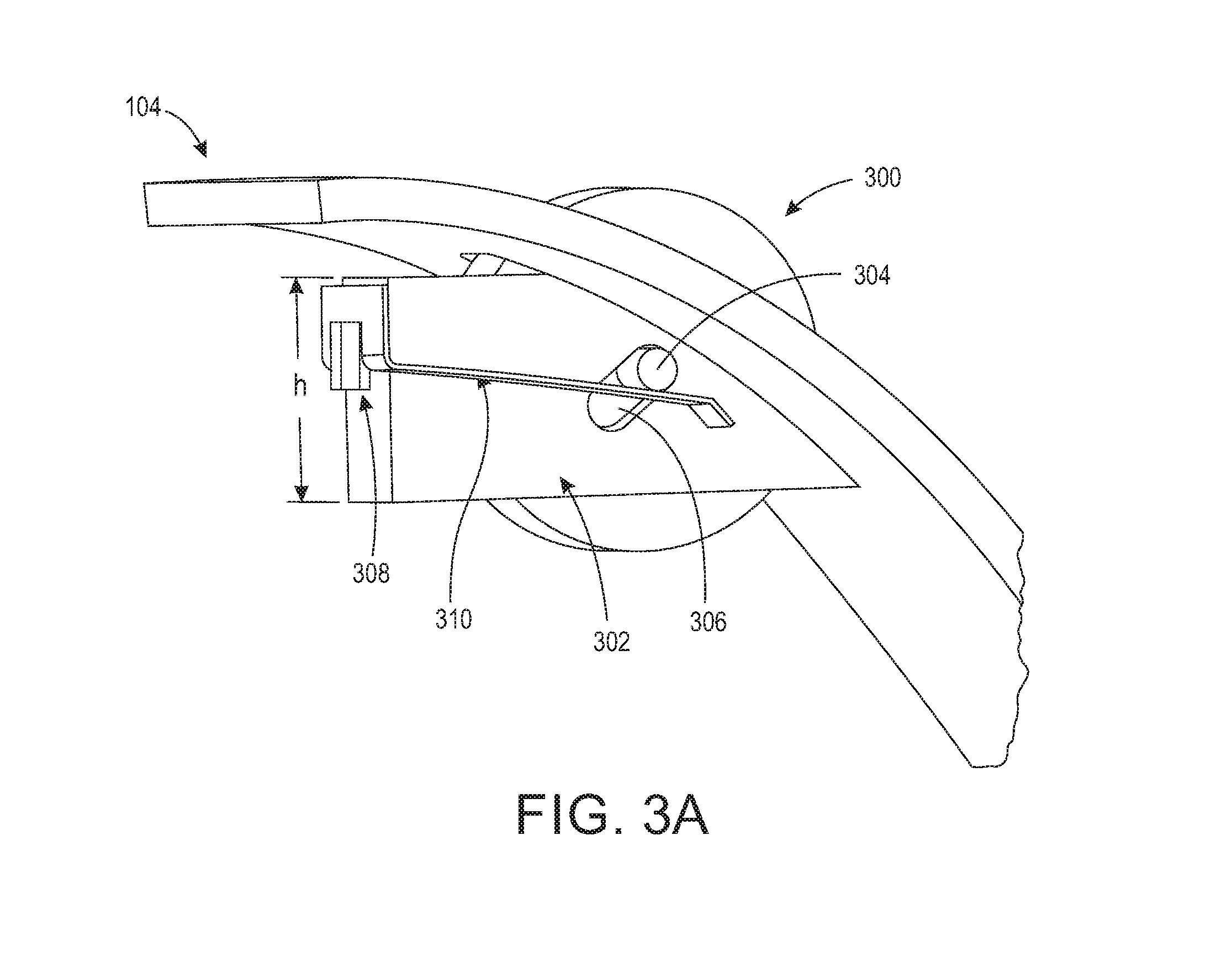
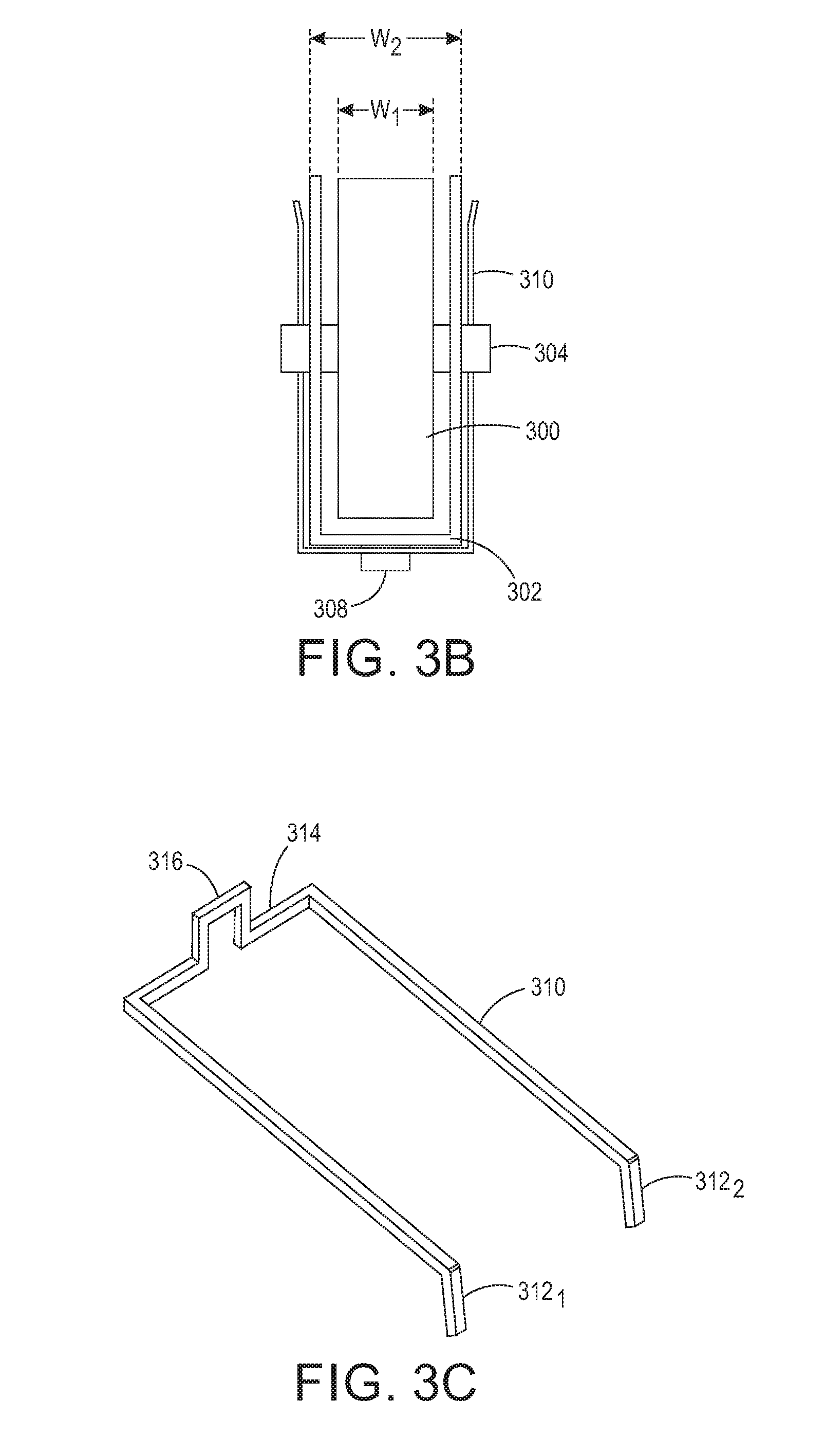
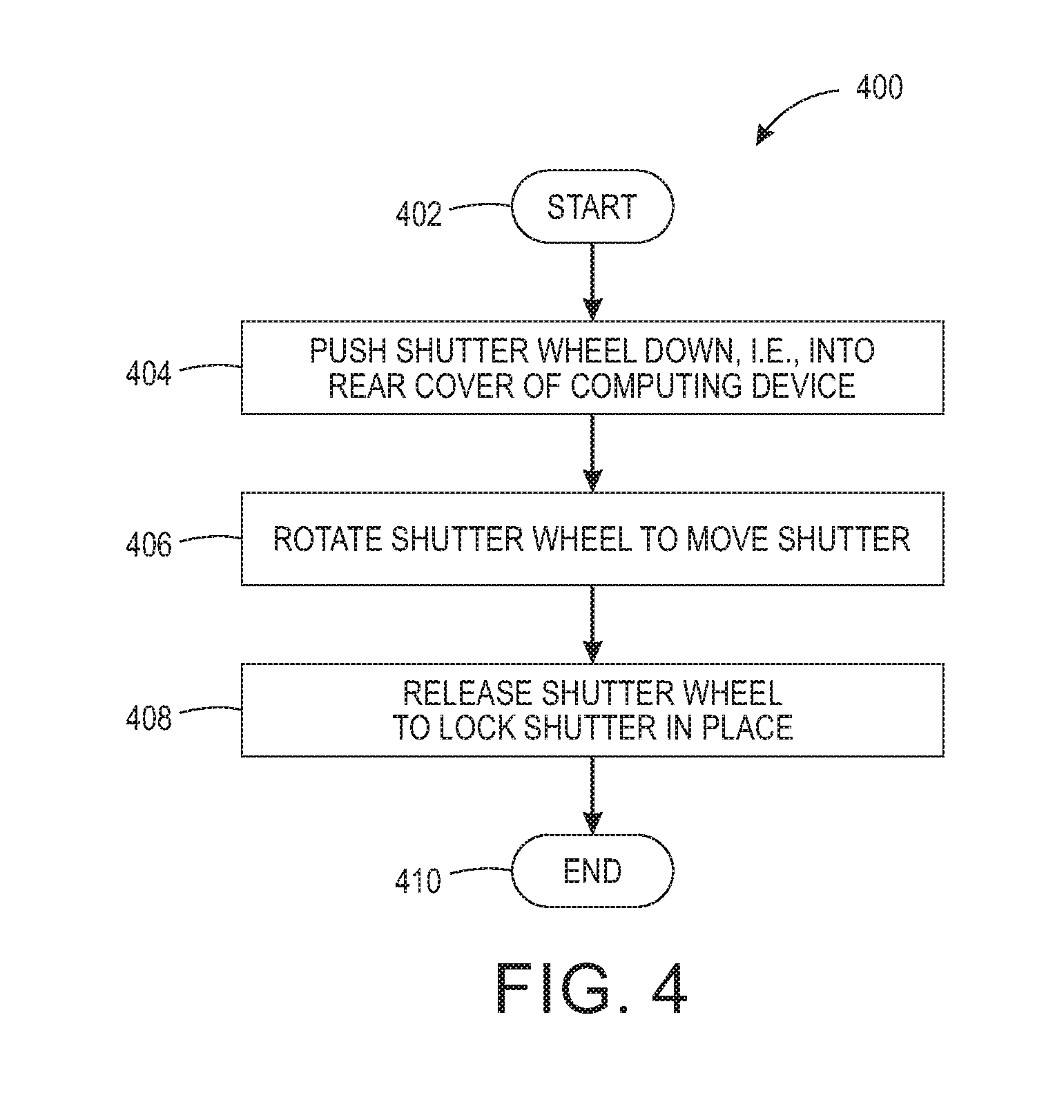
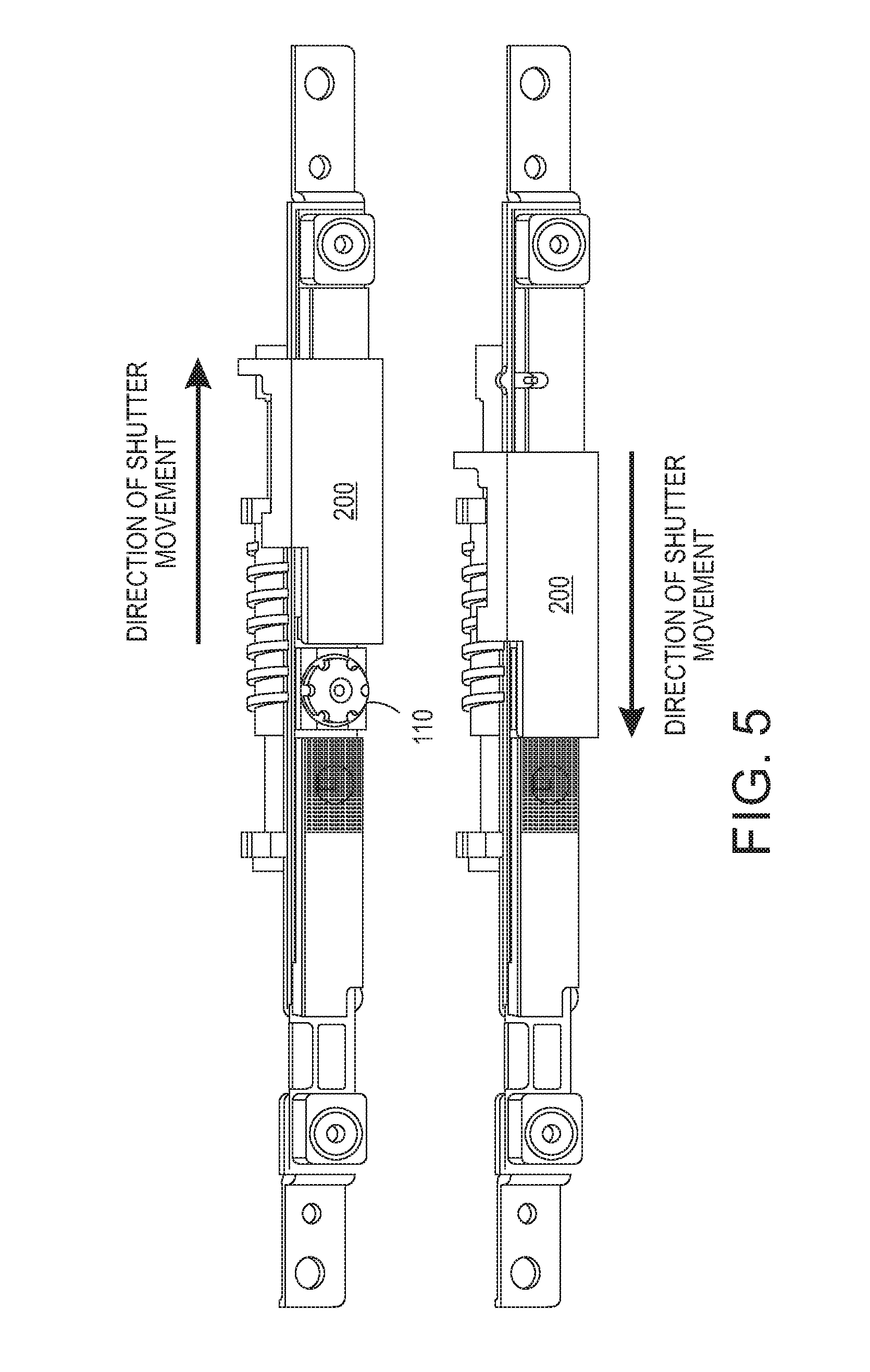
| United States Patent Application | 20190163034 |
| Kind Code | A1 |
| TSAI; Ming-Shan | May 30, 2019 |
WEBCAM SHUTTER
Abstract
In one example, a webcam shutter assembly includes a first sub-assembly and second sub-assembly formed independently of each other. The first sub-assembly includes a shutter for selectively covering a camera lens, and the second sub-assembly includes a manually operable actuator. The actuator is biased in a non-engaging arrangement with the shutter and is positioned to releasably engage the shutter for movement of the shutter in a lateral direction.
| Inventors: | TSAI; Ming-Shan; (Taipei, TW) | ||||||||||
| Applicant: |
|
||||||||||
|---|---|---|---|---|---|---|---|---|---|---|---|
| Family ID: | 56543979 | ||||||||||
| Appl. No.: | 16/264289 | ||||||||||
| Filed: | January 31, 2019 |
Related U.S. Patent Documents
| Application Number | Filing Date | Patent Number | ||
|---|---|---|---|---|
| 15544914 | Jul 20, 2017 | 10222680 | ||
| PCT/US2015/013660 | Jan 30, 2015 | |||
| 16264289 | ||||
| Current U.S. Class: | 1/1 |
| Current CPC Class: | H04N 5/2254 20130101; G06F 1/1607 20130101; G03B 11/043 20130101 |
| International Class: | G03B 11/04 20060101 G03B011/04; G06F 1/16 20060101 G06F001/16; H04N 5/225 20060101 H04N005/225 |
Claims
1-15. (canceled)
16. An apparatus, comprising: a shutter for selectively covering a camera lens; and a manually operable actuator positioned to engage the shutter for translation of the shutter in a lateral direction, wherein the manually operable actuator includes a threaded roller to convert rotation of the roller into translation of the shutter.
17. The apparatus of claim 16, wherein the shutter is mounted on the threaded roller.
18. The apparatus of claim 17, wherein the threaded roller comprises: a cylindrical body having a first end and a second end; and a threaded portion positioned between the first end and the second end.
19. The apparatus of claim 18, wherein the threaded roller further comprises: a first travel stop positioned at the first end of the cylindrical body; and a second travel stop positioned at the second end of the cylindrical body.
20. The apparatus of claim 19, wherein the first travel stop and the second travel stop are positioned to limit a distance in the lateral direction that the shutter travels.
21. The apparatus of claim 16, wherein the actuator comprises a wheel to engage with the threaded roller to rotate the threaded roller in response to manual rotation of the wheel.
22. The apparatus of claim 21, wherein the wheel is biased in a non-engaging arrangement with the shutter by a spring that applies a biasing force to an axle of the wheel.
23. The apparatus of claim 22, wherein the wheel is positioned to releasably engage the threaded roller when a pressure sufficient to overcome the biasing force is applied to the wheel.
24. The apparatus of claim 23, wherein the pressure is applied along a line that intersects an axis of travel of the shutter.
25. The apparatus of claim 16, wherein the shutter is fixed in position when the actuator and the shutter are disengaged.
26. An apparatus, comprising: a computing device having a front bezel and a rear cover; a camera integrated into the front bezel; a camera shutter positioned at the front bezel; and a manually operable actuator positioned to releasably engage the camera shutter for movement along a line that intersects an optical axis of the camera.
27. The apparatus of claim 26, wherein the actuator is biased in a non-engaging arrangement with the camera shutter.
28. An apparatus, comprising: a shutter coupled to a threaded roller and positioned to selectively cover or uncover a lens of a camera when the threaded roller is rotated; and a wheel positioned to engage the threaded roller to rotate the threaded roller to move the shutter.
29. The apparatus of claim 28, wherein the threaded roller is releasably engageable with the wheel.
Description
BACKGROUND
[0001] Modern computing devices often include integrated still or video cameras that can feed or stream images to a communication network--popularly, such devices are referred to as "webcams." For instance, a webcam may be integrated into the bezel of a computing device's display. Some webcams include a shutter that can be selectively moved in front of the camera lens to provide privacy when the user does not wish to transmit images.
BRIEF DESCRIPTION OF THE DRAWINGS
[0002] FIG. 1 illustrates an example webcam shutter assembly of the present disclosure;
[0003] FIG. 2 illustrates the example first sub-assembly of FIG. 1 in greater detail;
[0004] FIGS. 3A-3C illustrate the example second sub-assembly of FIG. 1 in greater detail;
[0005] FIG. 4 illustrates a flowchart of an exemplary method for operating the webcam shutter illustrated in FIG. 1; and
[0006] FIG. 5 illustrates the example webcam shutter in the "open" and "closed" positions.
DETAILED DESCRIPTION
[0007] The present disclosure broadly discloses a webcam shutter for bezel-integrated webcams. As discussed above, some webcams include a shutter to selectively provide privacy. When the user does not wish for the webcam to transmit images, the shutter is simply moved to cover the camera lens. The shutter can be removed from the camera lens when the user wishes to resume transmitting images. Some shutters include an actuator that is fixedly integrated into the shutter; the actuator thus adds to the thickness of the bezel. Actuators that are integrated into the shutter can also cause the shutter to be operated unintentionally, e.g., by the user accidentally bumping into the shutter.
[0008] Examples of the present disclosure provide a novel webcam shutter. For instance, examples of the present disclosure provide a two-piece shutter assembly including first and second sub-assemblies that are formed independently of each other, i.e., so that each can be fixed to a different portion of a computing device. The first sub-assembly is fixed to the front bezel of the computing device and includes a shutter mounted on a roller. The second sub-assembly is fixed to the rear cover of the computing device and includes a manual actuator positioned to releasably engage the roller. The actuator and the roller are biased in a non-engaging arrangement relative to each other; however, when the actuator engages the roller, the roller and the shutter are moved in a lateral direction, i.e., along a line that intersects the optical axis of the camera, to either cover or uncover the lens. The two-piece shutter assembly simplifies installation and maintenance of the shutter, accommodates thin form factor devices, and reduces the likelihood of unintentionally covering or uncovering the lens.
[0009] FIG. 1 illustrates an example webcam shutter assembly 100 of the present disclosure. In one example, the assembly 100 includes a first sub-assembly 102 and a second sub-assembly 104. The first sub-assembly 102 is fixed to the front bezel of a computing device in which the webcam is integrated, while the second sub-assembly 104 is fixed to the rear cover of the computing device. A portion 106 of the front bezel and a portion 108 of the rear cover are illustrated to show how the first sub-assembly 102 and the second sub-assembly 104 may be incorporated into the computing device; however, the computing device is not illustrated in its entirety. A portion of the webcam's lens 110 is also visible in FIG. 1.
[0010] FIG. 2 illustrates the first sub-assembly 102 of FIG. 1 in greater detail. In particular, FIG. 2 illustrates the portions of the first sub-assembly 102 that are hidden from view or are not visible in their entireties in FIG. 1. As discussed above, the first sub-assembly 102 is fixed to the front bezel of a computing device in which the webcam is installed. The first sub-assembly 102 generally comprises a shutter 200 mounted on a roller 204.
[0011] Referring simultaneously to FIG. 1 and FIG. 2, the shutter 200 comprises a door formed from an opaque or semi-opaque material. The shutter 200 is movable in a lateral direction, i.e., along a line A-A' that intersects the optical axis O of the camera, to selectively cover or uncover the lens 110. The shutter 200 has a substantially L-shaped cross section. A first leg 202.sub.1 of the shutter 200 is positioned to overlap the front bezel. A second leg 202.sub.2 of the shutter 200 meets the first leg 202.sub.1 at a substantially right angle, e.g., ninety degrees, within some tolerance; thus, the second leg 202.sub.2 of the shutter 200 is positioned to rest over the edge of the front bezel. The second leg 202.sub.2 of the shutter 200 also includes an aperture 216 that allows the shutter 200 to be mounted to the roller 204.
[0012] The roller 204 comprises a substantially cylindrical body 208. At each end of the body 208 is a travel stop 210.sub.1 or 210.sub.2, hereinafter collectively referred to as "travel stops 210." The roller 204 also includes a threaded middle portion 212 located between the two travel stops 210.
[0013] The roller 204 sits within a roller bracket 206. The roller bracket 206 serves as a support for the roller 204, and also as a limiter to control the roller's range of lateral motion. The length l.sub.1 of the roller 204 is greater than the length l.sub.2 of the roller bracket 206.
[0014] The roller bracket 206 includes a first aperture 214.sub.1 formed in a first end of the roller bracket's frame and a second aperture 214.sub.2 formed in a second end of the roller bracket's frame. The roller 204 is seated within the roller bracket 206 such that the threaded middle portion 212 of the roller 204 is positioned between the first aperture 214.sub.1 and the second aperture 214.sub.2; the travel stops 210 of the roller 204 protrude beyond the ends of the roller bracket's frame. In this position, the roller 204 may rotate within the roller bracket 206.
[0015] FIGS. 3A-3C illustrate the second sub-assembly 104 of FIG. 1 in greater detail. In particular, FIG. 3A illustrates an isometric view of the second sub-assembly 104; FIG. 3B illustrates a top view of a portion of the second sub-assembly 104; and FIG. 3C illustrates an isometric view of a portion of the second-sub-assembly 104. As discussed above, the second sub-assembly 104 is fixed to the rear cover of a computing device in which the webcam is installed. The second sub-assembly 104 generally comprises a shutter wheel 300 mounted within a wheel housing 302.
[0016] The shutter wheel 300 includes a short axle 304 disposed through the center of the shutter wheel 300, such that one end of the axle 304 protrudes from each side of the shutter wheel 300.
[0017] The wheel housing 302 is fixed to an interior surface of the computing device's rear cover and defines a hollow volume within which the shutter wheel 300 sits. The width w1 of the shutter wheel 300 (not including the axle 304) is smaller than the interior width w2 of this hollow volume. A height h of the wheel housing 302 is smaller than the diameter of the shutter wheel 300, such that when the shutter wheel 300 is seated within the wheel housing 302, a portion of the shutter wheel 300 protrudes beyond the boundaries of the wheel housing 302.
[0018] Each side of the wheel housing 302 includes an elongated slot 306 for receiving a portion of the shutter wheel's axle 304 when the shutter wheel 300 is seated in the wheel housing 302. In addition, an exterior surface of the wheel housing 302 includes a flange 308 for supporting a spring 310. As illustrated, the spring 310 is substantially U-shaped, having two tines 312.sub.1 and 312.sub.2, hereinafter collectively referred to as "tines 312," that extend from a base 314. The base 314 additionally includes a notch 316. When the notch 316 of the spring 310 is seated on the flange 308 of the wheel housing 302, the tines 312 of the spring 310 extend along the sides of the wheel housing 302, at roughly the height of the elongated slot 306. As illustrated in FIG. 3A, the tines 312 of the spring 310 are positioned below the axle 304 of the shutter wheel 300; this arrangement biases the shutter wheel 300 in an upward position.
[0019] FIG. 4 illustrates a flowchart of an exemplary method 400 for operating the webcam shutter illustrated in FIG. 1. As discussed above, the webcam shutter assembly 100 is manually operable by a user.
[0020] At block 402, the method 400 begins. At block 404, the user pushes the shutter wheel 300 down, i.e., in a direction into the rear cover of the computing device. The downward pressure is sufficient to overcome the bias of the spring 310, and the axle 304 of the shutter wheel 300 is allowed to slide downward in the elongated slot 306 of the wheel housing 302. As a result, the shutter wheel 300 engages the threaded middle portion 212 of the roller 204.
[0021] At block 406, the user rotates the shutter wheel 300. As the shutter wheel 300 rotates, it engages the threads of the roller's threaded middle portion 212, causing the roller 204 to rotate. As the roller 204 rotates, the roller 204 moves laterally within the roller bracket 206, i.e., along an axis of travel that intersects a line along which the downward pressure is applied and also intersects the optical axis of the webcam. The shutter 200, which is mounted to the roller 204, also moves laterally. The direction in which the shutter wheel 300 is rotated will control the lateral direction within which the roller 204 moves. Depending on which lateral direction the roller 204 moves, the shutter 200 will move to either cover or uncover the lens 110, as illustrated in FIG. 5, which illustrates the webcam shutter 200 in the "open" and "closed" positions. Lateral movement of the shutter 200 is limited by the travel stops 210 on the roller 204, which prevent the shutter 200 from moving too far in either direction; when the roller 204 is rotated far enough for one of the travel stops 210 to meet the frame of the roller bracket 206, the roller 204 can travel no further in that direction.
[0022] At block 408, the user releases the shutter wheel 300, once the webcam shutter 200 has been moved to the desired location. Without the downward pressure, the spring 310 moves back into its resting position. Movement of the spring 310 biases the shutter wheel 300 upward, i.e., away from the roller 204, such that the shutter wheel 300 releases or is disengaged from the threaded middle portion 212 of the roller 204. The webcam shutter 200 is now "locked" or fixed in position until or unless the user repeats blocks 404-406.
[0023] The method 400 ends in block 410.
[0024] Thus, the shutter wheel 300 operates as an actuator for the webcam shutter assembly 100. In particular, under manual actuation, the shutter wheel 300 releasably engages the roller 204 and causes the roller 204 to rotate. Rotation of the roller 204 moves the shutter 200 in a lateral direction, to either cover or uncover the lens of the webcam. Manual actuation requires the exertion of both downward pressure on the shutter wheel 300 (to engage the roller 204) and rotation of the shutter wheel 300 (to cause movement of the roller); thus, it is very difficult to cause unintentional actuation of the webcam shutter assembly 100. Moreover, because the actuator is fixed to the rear cover of the computing device, the bezel does not have to be enlarged to support the webcam shutter assembly 100, and the computing device can maintain an overall form factor that is thin and compact. In addition, because the actuator is incorporated into the rear cover of the computing device, the actuator can be easily accessed for installation and maintenance without requiring the bezel to be removed.
[0025] It will be appreciated that variants of the above-disclosed and other features and functions, or alternatives thereof, may be combined into many other different systems or applications. Various presently unforeseen or unanticipated alternatives, modifications, variations, or improvements therein may be subsequently made by those skilled in the art which are also intended to be encompassed by the following claims.
* * * * *
D00000

D00001

D00002

D00003

D00004

D00005

D00006

XML
uspto.report is an independent third-party trademark research tool that is not affiliated, endorsed, or sponsored by the United States Patent and Trademark Office (USPTO) or any other governmental organization. The information provided by uspto.report is based on publicly available data at the time of writing and is intended for informational purposes only.
While we strive to provide accurate and up-to-date information, we do not guarantee the accuracy, completeness, reliability, or suitability of the information displayed on this site. The use of this site is at your own risk. Any reliance you place on such information is therefore strictly at your own risk.
All official trademark data, including owner information, should be verified by visiting the official USPTO website at www.uspto.gov. This site is not intended to replace professional legal advice and should not be used as a substitute for consulting with a legal professional who is knowledgeable about trademark law.